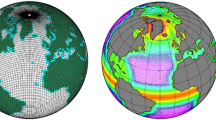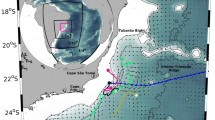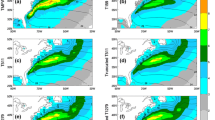Summary
The performance of three different vertical mixing schemes embedded in a global coarse resolution OGCM under both annual and monthly mean forcing are compared. These schemes are the integral model of Kraus and Turner and the differential parametrisations of Pacanowski and Philander and Henderson-Sellers (EDD1 scheme). The simulations of mean climatological conditions suggest that, with respect to climate change studies, the Kraus-Turner and the EDD1 schemes are overall more robust than the Pacanowski and Philander parametrisation. With respect to anomalous climatic conditions (i.e. decay of imposed SST anomalies), all three schemes indicate that the lifespan and penetration depth of a cold anomaly is somewhat greater than for a warm one. Also, the EDD1 scheme portrays the evolution process of the SST anomalies somewhat differently than the other two schemes.
Similar content being viewed by others
References
Adamec, D., Elsberry, R. L., Garwood, R. W., Jr., Haney, R. L., 1981: An embedded mixed layer-ocean circulation model.Dyn. Atmos. Oceans,5, 69–96.
Alderson, S. G., 1990: On embedding a mixed layer model into an ocean general circulation model.Dyn. Atmos. Oceans,15, 59–86.
Bryan, K., 1969: A numerical method for the study of the circulation of the world ocean.J. Computat. Phys.,4, 347–376.
Bryan, K., Lewis, L. J., 1979: A water mass model of the world ocean.J. Geophys. Res.,84, 2503–2517.
Cox, M. D., 1984: A primitive equation, 3-dimensional model of the ocean.GFDLOcean Group Technical Report No. 1, Princeton University.
Esbensen, S. K., Kushnir, Y., 1981: The heat budget of the global ocean: an atlas based on estimates from surface marine observations.Oregon State University Climate Research Institute Report,29, 27 pp.
Foreman, S. J., 1986: Ocean and atmosphere interact.Meteor. Mazine. 115, 358–361.
Gaspar, Ph., 1988: Modelling the seasonal cycle of the upper ocean.J. Phys. Oceanogr.,18, 161–180.
Gaspar, Ph., Gregoris, Y., Stull, R., Boissier, Ch., 1988: Long-term simulations of upper ocean vertical mixing using models of various types. In: Nihoul, J. C. J., Jamart, B. M. (eds.)Small-Scale Turbulence and Mixing in the Ocean. 19th International Liege Colloquim on Ocean Hydrodynamics, Elsevier, 169–184.
Hellerman, S., Rosenstein, M., 1983: Normal monthly wind-stress over the world ocean with error estimates.J. Phys. Oceanogr.,13, 1093–1104.
Henderson-Sellers, B., 1985: New formulation of eddy diffusion thermocline models.Appl. Math. Medel.,9, 441–446.
Henderson-Sellers, B., 1988: Embedding stratification models in ocean general circulation climate models. In: Nihoul, J. C. J., Jamart, B. M. (eds.)Small-Scale Turbulence and Mixing in the Ocean. 19th International Liege Colloquim on Ocean Hydrohynamics. Elsevier, 95–107.
Kraus, E. B., 1988: Merits and defects of different approaches to mixed layer modelling In: Nihoul, J. C. J., Jamart, B. M. (eds.)Small-Scale Turbulence and Mixing in the Ocean. 19th International Liege Colloquim on Ocean Hydrodynamics. Elsevier, 37–50.
Kraus, E. B., Turner, J. S., 1967: A one-dimensional model of the seasonal thermocline. II: The general theory and its consequences.Tellus,19, 98–105.
Kraus, E. B., Bleck, R., Hanson, H. P., 1988: The inclusion of a surface mixed-layer in a large-scale circulation model. In: Nihoul, J. C. J., Jamart, B. M. (eds.)Small-Scale Turbulence and Mixing in the Ocean. 19th International Liege Colloquim on Ocean Hydrodynamics. Elsevier, 51–62.
Kühnel, I., Henderson-Sellers, B., 1991: Mixed layer modelling with respect to ocean-atmosphere interactions in the eastern Indian Ocean.Meterol. Atmos. Phys. 46, 51–64.
Levitus, S., 1982: Climatological atlas of the world ocean. NOAA Professional Paper,13, U.S. Govt. Printing Office, 173 pp.
Mellor, G. L., Yamada, T., 1982: Development of a turbulence closure model for geophysical fluid problems.Rev. Geophys. Space Phys.,20, 851–857.
Moore, A. M., Reason, C. J. C., 1993: The response of a global ocean general circulation model to climatological surface boundary conditions for temperature and salinity.J. Phys. Oceanogr. (in press).
Niiler, P. P., Kraus, E. B., 1977: One-dimensional models of the upper oceans. In: Kraus, E. B. (eds.)Modelling and Prediction of the Upper Layers of the Ocean. Pergamon, 143–172.
Pacanowski, R. C., Philander, S. G. H., 1981: Parameterization of vertical mixing in numerical models of tropical oceans.J. Phys. Oceanogr.,11, 1443–1451.
Philander, S. G. H., 1990:El Nino, La Nina, and the Southern Oscillation. San Diego: Academic Press, 289 pp.
Reason, C. J. C., 1993: On the effect of ENSO precipitation anomalies in a global OGCM.Clim. Dyn. (in press).
Rosati, A., Miyakoda, K., 1988: A general circulation model for upper ocean simulation.J. Phys. Oceanogr.,18, 1601–1626.
Semtner, A. J. Jr., Chervin, R. M., 1988: A simulation of the global ocean circulation with resolved eddies.J. Geophys. Res. 93, 15, 502–515, 222.
Smith, T. N., Gordon, H. B., 1992: Simulations of precipitation and atmospheric circulation changes associated with warm SSTs: results from an ensemble of long term integrations with idealized anomalies.Climate Dyn.,7, 141–153.
Verron, J., Le Provost, C., 1991: Response of eddy-resolved general circulation numerical models to asymmetrical wind forcing.Dyn. Atmos. Oceans. 15, 505–533.
Wacongne, S., 1988.The Dynamics of the Equatorial Undercurrent and its Termination. PhD thesis, Woods Hole Oceanographic Institution, Woods Hole, Massachusetts.
Author information
Authors and Affiliations
Additional information
With 9 Figures
Rights and permissions
About this article
Cite this article
Reason, C.J.C., Kühnel, I. & Henderson-Sellers, B. A comparison of vertical mixing schemes embedded in an OGCM with application to air-sea interactions and the evolution of SST anomalies. Meteorl. Atmos. Phys. 51, 55–71 (1993). https://doi.org/10.1007/BF01080880
Received:
Issue Date:
DOI: https://doi.org/10.1007/BF01080880




